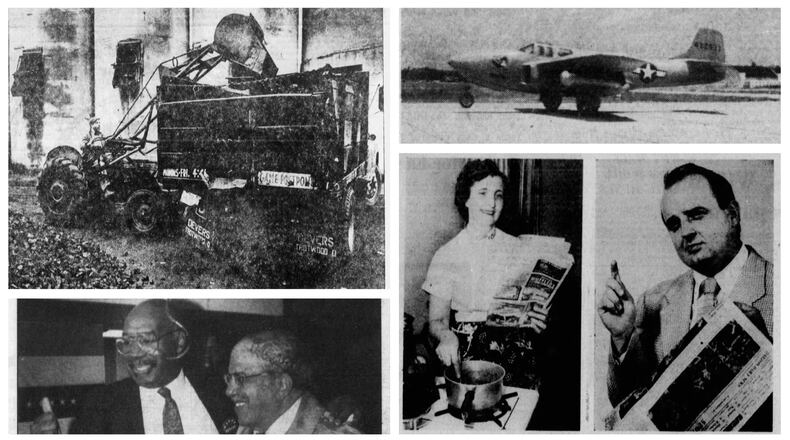Here’s a look at some stories happening the week of Nov. 5-11.
Nov. 6, 1945: Jet plane flown and landed under remote control at Wright Field
Officials of the Air Technical Service Command, Wright Field, working with Bell Aircraft Corp. disclosed the development of their new technology.
They had teamed up to make it possible to fly full-sized airplanes under remote control.
In tests, a P-59 Airacomet was controlled from either another P-59 in flight or from a ground station. The ground station was a truck with a televison and telemetering equipment.
Contol of the “robot plane” was set by contols similar to that in a conventional plane. Pilots could remotely control warm-up, taxiing, takeoff, climb, level flight, banks or turn dives, loops and all other maneuvers.
A camera in the “robot plane” could televise a view of the robot’s instruments and a horizon view normally seen by the pilot.
Success of the project was credited to Robert M. Stanley, chief engineer for the Bell Corporation, who created the design for the new automatic pilot arrangement.
Nov. 5, 1957: Housewife and cab driver divide ‘Prophet’ payoff
In 1957, the Dayton Daily News ran a contest each week called “Pigskin Prophet” with a prize of up to $250 if all the games were picked correctly. Readers mailed in a form cut from the newspaper with their college football picks for the week.
This week was a tie between “a secretive housewife and a temporary taxicab driver.” They each picked 13 correct results (out of 15 possible games) and also tied on the tie-breaker. They split the $50 in winnings.
Mrs. Harold Binns was the first ever female Prophet winner. Did she have help? “Oh, no, I won’t even show my selections to my husband until Sunday morning,” said Binns. She even correctly picked a tie between Iowa and Michigan.
Bill Domurath, the other winner, was laid off as a milkman a couple of weeks prior so he had been driving a cab until he could find other work. Domurath said he had been trying his luck in football guessing games for 21 years, and this was the first time he had won anything.
The contest had 15,374 entries.
Nov. 10, 1968: Earthquake rattles Dayton
Some Dayton area residents hardly noticed the tremors that occurred on a Saturday at noon. But the earthquake had a rattling effect on others, especially a handful of workers on the top floors of the 20-story Hulman building.
“It scared the devil out of me,” said Dee Graham, a secretary on the 20th floor.
Graham was one of four employees of the Gallon & Miller law firm working overtime on Saturday.
“If we had a full crew (15), we would have had mass hysteria,” she said.
One worker said the tremors lasted just one minute, but others said they lasted five to 10 minutes. Seismograph readers later determined the event lasted between eight and nine minutes.
Attorney Jerome Bohman was on the 18th floor. “I stood up and my legs were wobbling,” he said, “I tell you I was frightened.”
The quake registered a 5.5 on the Richter scale and could be felt all over the state from the Ohio River all the way to Lake Erie.
Dr. Benjamin Richard, assistant professor of geology at Wright State university called it a “mediocre” shock as far as damage goes yet it was probably one of the stronger earth tremors in this part of the country in many years.
Nov. 6, 1977: Daytonians still need ... COAL
In 1940, there were more than 100 retail coal dealers in Dayton. Nearly every home had a coal furnace. So did most businesses and manufacturing plants.
In 1977, only one retail coal business remained, the Edgemont Coal and Cement Co., located at 1611 Germantown Pike.
Richard Allen had been working in coal yards since 1936, was was still at it, working part-time delivering coal to people’s homes.
“More people than you might imagine still heat their homes with coal in the Dayton area,” said Allen. Many burn it in their fireplaces and Ben Franklin-style stoves.
Deliveries were made as far away as Waynesville, Farmersville and Fairborn. The biggest coal user in the city was the Miami Valley Regional Transit Authority, which was delivered 30 or 40 tons at a time. RTA used between 185 and 240 tons of coal each winter to heat their maintenance facility.
Customers lined up in the winter to buy 100-pound bags of coal, which were sold $5 a bag. In 1942, a ton of coal would cost $9.50, in 1977 it was up to $75.50.
The coal business in Dayton faced a major setback in 1953 when Dayton Power and Light Co. started allowing gas permits for the area and many households converted to gas furnaces.
A search of Google Maps indicated the business has since been torn down.
Nov. 8, 1989: Dixon coasts to mayoral victory
Dayton Mayor Richard Clay Dixon trounced opponent Abner Orick in the November 1989 election.
Dixon was re-elected with 59 percent of the vote to Orick’s 41 percent.
During the race, Orick chanllenged Dixon to a drug-test and accused Dixon of letting drugs and crime get out of hand in Dayton.
Dixon said he held no personal animosity toward Orick, despite the two both attacking each other with negative TV and radio ads.
Dixon was the director of adult basic education for the Dayton City School District. He won his first election to the commission in 1979. He was appointed by that commission to fill the mayor’s seat after former Mayor Paul Leonard left to become the state’s lieutenant governor.
About the Author






